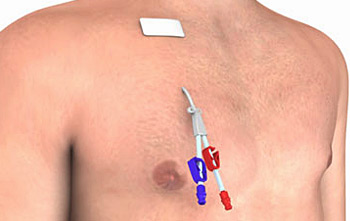
Management of Central Lines: Current Standards of Practice
This course has been designed to provide basic conceptual and operational knowledge to healthcare clinicians responsible for the care of patients with central venous access devices. As the science of infusion therapy advances and technology expands, it is imperative that all healthcare clinicians and nurses practicing infusion therapy remain current in their knowledge of infusion therapies, principles, techniques, equipment and the latest in infusion evidence based practices.
In early 2024, the Infusion Nurses Society (INS), recognized as the global authority in infusion therapy, released the updated Infusion Therapy Standards of Practice. The INS sets the accepted standards for infusion therapy practice for all healthcare settings. This course is based on the current best practices as defined by the Infusion Nursing Society and other governing agencies such as the CDC, and FDA.
Many governing boards require nurses, nursing assistive personnel, radiology technicians, EMT’s, paramedics and respiratory therapist to have additional infusion therapy education after licensure. These requirements vary by state and governing board. To view each state's Board of Nursing you may reference the resources section of the website or click here. Competency requirements are obtained and maintained through the healthcare provider's employer, facility or institution, with a preceptor. The number of times a procedure must be repeated to demonstrate competency will be determined by the employer or as stipulated by the Board of Nursing or other governing agency of the profession. Pedagogy has developed skill check-off lists for all infusion related procedures and these are available in the course for print out and completion with a preceptor.
Questions? Check out our FAQs page and How Online IV Certification Works!
In early 2024, the Infusion Nurses Society (INS), recognized as the global authority in infusion therapy, released the updated Infusion Therapy Standards of Practice. The INS sets the accepted standards for infusion therapy practice for all healthcare settings. This course is based on the current best practices as defined by the Infusion Nursing Society and other governing agencies such as the CDC, and FDA.
Many governing boards require nurses, nursing assistive personnel, radiology technicians, EMT’s, paramedics and respiratory therapist to have additional infusion therapy education after licensure. These requirements vary by state and governing board. To view each state's Board of Nursing you may reference the resources section of the website or click here. Competency requirements are obtained and maintained through the healthcare provider's employer, facility or institution, with a preceptor. The number of times a procedure must be repeated to demonstrate competency will be determined by the employer or as stipulated by the Board of Nursing or other governing agency of the profession. Pedagogy has developed skill check-off lists for all infusion related procedures and these are available in the course for print out and completion with a preceptor.
Questions? Check out our FAQs page and How Online IV Certification Works!
Objectives
Upon completion of the course, participants should be able to:
- Describe protective measures to guard against malpractice suits.
- List reasons for use and advantages of central lines.
- List veins used for central venous device placement and proper tip position.
- Identify the various types of central lines.
- Identify symptoms and prevention of complications.
- Describe assessment criteria and documentation required for patients with central venous catheters.
Curriculum
Chapter 1: Central Line Review
- Definition of a Central Line
- Reasons for use of a central line
- Advantages of a central lines
- Overview of Central Venous Access Devices
- Lumens
- Non‐valved and valved catheters
- Non‐tunneled catheters
- Tunneled catheters
- Implanted ports
- PICC or Peripherally Inserted Central Catheter
- Veins used for placement of central venous access devices
- Catheter tip placement
- Considerations for selection of the device
- Preparations for central venous catheterization
- Needleless Connectors
- CVAD Stabilization
- Site Protection
- Flushing and Locking
- Assessment, Care, and Dressing Changes
- Administration Set Changes
- Blood Sampling from a CVAD
- Catheter related complications
- Systemic complications
- Insertion related complications
- Removal of devices
- Central venous access device removal procedure
- Documentation of insertions, removal, infiltration or extravasations
- Assessment, monitoring, documentation by type of therapy
- Accessing a Port
- Administration of Infusate Via an Ambulatory Infusion Pump
- Blood Specimen Collection From a CVAD
- De-Accessing an Implanted Port
- Electronic Infusion Device Programming
- Medication Administration
- Midline or Central Line Dressing Change
- Needleless Connector Device Change
- Removal of a Non-Tunneled Catheter
- California BON Required Implicit Bias Information
Price: $60.00
Contact Hours: 4

Course Author

Capra Garrison
Capra Garrison, Registered Nurse, has more than 33 years of experience in infusion therapy and the instruction of licensed nurses in infusion therapy continuing education. Her experience comes from multiple infusion settings: acute care, ambulatory infusion centers, home infusion, long term care continuing education provider, and long term care pharmacy quality assurance consultant. Capra has an avid interest in holistic healing, nutrition, herbs, and alternative therapies for the treatment of disease in humans as well as animals.
Read Full Bio
Course Accreditation
See our Accreditation Statements page to view our accreditation information.